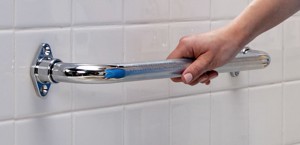
Clinical considerations for the selection of adaptive bathroom equipment
By Sam L. Adams, OTR/L
Selecting Bathroom Safety Equipment
On a regular basis, we clinicians are charged with the task of identifying appropriate bathroom equipment for our clients. As they progress in establishing a daily self-care routine, we play a key role in assisting and advocating for our clients’ health, independence, safety and dignity through the selection of showering and toileting equipment.
Where should we start? What should we consider? What equipment options are out there? Do equipment options change along the way between initial mobilization and discharge? Are we assuring clients’ knowledge, performance and satisfactions are optimized with return for follow-up? How and where can we do better in our decision-making regarding selection of adaptive bathroom equipment and education of those we serve?
Phase by phase
Just as in the case of an initial mobilization from bed to a demonstration or trial wheelchair for mobility purposes, the process of selecting bathroom equipment should follow a protocol of phases.
• Phase one: “demo equipment”–meeting our short term goals.
• Phase two: “definitive equipment”–meeting our long term goals.
In phase one, we select a piece of equipment that will allow the client to get out of bed and to safely and successfully use the bathroom.
Following equipment evaluation–when it is established that the client and nursing staff are good to go with initial equipment set-up, adequate access to the bathroom environment on the ward, sitting tolerance and the assistance needed to safely complete toileting tasks in a seated position–we move toward phase two.
In phase two, we select a definitive piece of equipment that will optimize the long-term goals established in preparation for the client’s discharge.
Look to the goals
Just as with the selection of manual or power mobility devices, it all starts with what is most important to the client: that person’s goals. First stop: posture and seating evaluation. We educate along the way regarding why we do what we do, while emphasizing the importance of assessment of alignment, evaluation of flexibility and assurance of adequate skin protection, optimal trunk balance, appropriate line of sight, maximized upper-extremity function and peak independence.
Why are we not pressure mapping on bathroom equipment? Are we educating our clients, their family members and caregivers regarding “OK” areas for pressure, concepts of forced isolation and areas to avoid weight-bearing? Are we assuring a means of effective pressure relief is granted, especially in cases where individuals are spending hours on equipment issued with intention for daily use?
Just as with selection of a wheelchair, appropriate pelvic positioning is crucial, especially when we have the ability to improve peristalsis or defecation, increase independence and shorten the amount of time clients are spending in the bathroom so that they can get off the pot and get on with their day!
What can we improve in functional performance in the bathroom when we grant someone increased pelvic stability through the selection of a specific commode or bathing surface? What function might we be inhibiting with the selection of certain types of equipment?
Applying mobility to the bathroomWhat exactly is out there in the way of bathroom equipment options? What is there in the way of seating components such as recline, tilt-in-space and elevation to optimize the management of blood pressure, skin protection, trunk balance, comfort, pain, spasticity, bowel and bladder emptying, independence and quality of life? What seating options best preserve shoulder function, offer energy conservation and assure patient and caregiver safety? As we apply custom seating options to our designer mobility end products, are we considering the application of those same custom modifications and adjustments to our clients’ bathroom equipment?
We address hypotension with slow, progressive mobilization protocols and later teach family members and caregivers manual tilt-back methods with transition from reclining to lightweight manual wheelchairs. Why are we not instructing ways in which to address hypotension and including tilt components with orders for bathroom equipment? Are we doing all that we can do to advocate for an individual’s quality of life when the person says, “I just get a sponge bath in bed because my blood pressure drops in the shower”?
Just as we train our clients in the performance of mobility skills such as pressure releases, transfers and downhill travel at the wheelchair level, we need to address those same mobility and activities of daily living skills in the bathroom on the rolling shower commode chair, raised toilet seat and transfer tub bench.
As clinicians, we need to improve our customer service and skills in adaptation, while fitting the equipment to both the patient and the patient’s environment.
Share what we know
In many cases, our clients identify the goal of being as independent as possible–but often are not aware of what bathroom equipment options are available to them. Even fewer people are aware of what adjustments or modifications have been trialed to grant more stability, better functional performance and potential improvements in independence with the performance of daily self-care. Thus, the take home message is “share what we know.”
Yes, procurement of higher-cost adaptive bathing and toileting equipment is expensive and, in most facilities, not covered by insurance. However, like all other pieces of durable medical equipment, medical justification can be established, presented to insuring agencies and passed along to the clinicians and clients using that equipment. There is a reason why insurance agencies no longer require all chair users to be in a Breezy manual or E&J power wheelchair. It is our obligation to learn about, trial, document and educate others regarding the benefits of using advanced equipment options that provide our clients with improved health and better living.
Follow-up is key
We need to include a re-evaluation of performance of bathing and toileting tasks in every client’s follow-up assessment, be it at the initial evaluation with clients new to our location, with those in advanced rehabilitation or at our annual evaluation. Research tells us that our clients go home after discharge from the initial rehabilitation and continue to make progress. Our assessment, knowledge of equipment options and ability to optimize function, control, independence, health, education and intervention must progress with them.
Adapted from a presentation to the International Seating Symposium.
Reprinted with permission from Rehab & Community Care Medicine magazine



